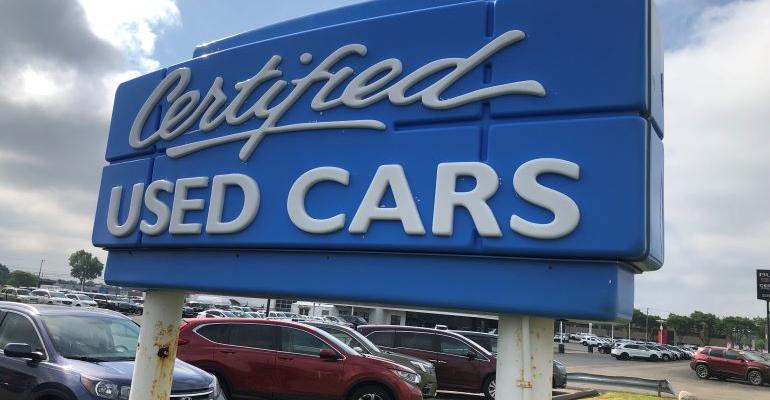Today’s high vehicle prices are juicing up an idea that hadn’t previously garnered much serious attention: used-car leasing.
For years, used-car leasing seemed like a concept of the future – and always would be.
It had some auto industry advocates, such as Dave Ruggles, a former dealership general manager. But he scratched his head, wondering why others didn’t feel the way he did about the subject.
Skeptics thought used-car leasing was theoretically interesting enough but, in reality, carried too many risks. They contended it was hard enough to predict the residual value of a new vehicle two or three years out, let one do such forecasting for a four- or five-year-old vehicle.
But today’s sophisticated predictive analytics – and a topsy-turvy market where demand outpaces supply, propelling high car prices – is giving legs to the prospects of leasing pre-owned vehicles.
“There’s a huge opportunity coming for lending institutions to get in the used leasing business,” says Rusty West, CEO of the automotive data services firm MarketScan.
He sees such leasing as helping to ease the consumer pain and the auto-lending risk of car buyers taking out big loans at high-interest rates for prolonged terms.
The auto industry is in ‘the weirdest position’
“The industry is in the weirdest position I’ve ever seen, and I have been in it since 1988,” West tells Wards.
A chronic parts shortage forced automakers to cut production. That put fewer vehicles on dealer lots. That seller’s market led to consumers paying premium prices, often thousands of dollars over MSRP, a practice unheard of a few years ago.
It also led many consumers to head to the used-car lot, where they suffered a slightly milder sticker shock.
And the higher vehicle prices have led to sky-high auto loans.
“If we continue to shove customers into 84-month and 96-month auto contracts, then we are going to create a difficult environment,” West says. “We must get back to what’s good for the whole automotive ecosystem. Focus on getting back to a healthy transaction.”
That’s arguably happening incrementally as dealer inventories build back up. But the average new vehicle price this year has increased to $46,229, according to J.D. Power. In 2021 it was $40,400.
West describes himself as “super passionate” about leasing overall. It allows consumers to buy new vehicles more often at more affordable monthly payments. Dealers like it because it returns customers to their stores when their two- or three-year leases expire.
Leasing in the early 2000s made up nearly 40% of auto deliveries. It’s dropped to under 20% now, according to Cox Automotive, an automotive-services company.
That drop is primarily because automakers’ captive lending companies stopped offering subvented deals to move the metal. The metal – what there was of it during the recent chronic inventory dearth – was moving well enough without help from sweetheart lease deals, customer incentives or rebates.
A strong comeback for leasing?
“I think leasing is going to make a strong comeback,” says West, whose father was a leasing pioneer of the late 1950s. He spearheaded a program that became Ford Red Carpet Leasing.
Rusty West lauds leasing for helping consumers avoid getting bogged down by long-term, high-interest loans with monthly payments pushing $1,000 on purchased high-priced vehicles.
“We’ve got people whose car payments are higher than their mortgage payments,” West says. “That may look good on a balance sheet, but there is a price to pay.”
By whom?
“Everyone,” he replies.
That includes lenders who increase the risk of borrowers potentially defaulting if loan amounts and interest rates are too high and terms too long.
Over-extension on used-vehicle loans is the current No.1 concern for credit unions in the 2023 auto-finance landscape, according to Credit Union Leasing of America (CULA).
The results of its online survey of credit union professionals indicate that they continue to offer car buyers a significant percentage of longer-term loans with low down payments on high-mileage older vehicles.
Over-extension loan practices “no surprise”
The majority are extending loan-to-value by more than 125% to cover the cost of the vehicle as well as extras, such as finance and insurance products and services.
“It was no surprise to us that over-extension on used-vehicle loans is generating significant worry for credit unions, as is overall used-vehicle affordability,” says Mark Chandler, CULA’s vice president-business development.
He’s concerned that credit unions “will continue to incur unnecessary risk if they don’t find an alternative to the long-term used auto loan, which they continue to offer in significant numbers – and on vehicles that present potential risk.”
He reports that some of the surveyed credit unions give eyebrow-raising 84-month loans on six- and seven-year-old vehicles.
Used-vehicle leasing is Chandler’s proposed solution to reducing lending risks.
“It checks all the boxes,” he tells Wards. “For lenders, it’s low-risk, good-yield and short-term. For consumers, it really comes down to affordability.”
His firm, part of Westlake Financial Services, does residual-value predictions and manages risk for credit unions that offer used-car leasing. (Cars eight years old and older aren’t eligible.)
CULA originated 64,000 leases through its credit union partners last year. The company calls leasing a powerful short-term, low-risk, strong-yield option.
“Used-car leasing remains in the minority, but it is gaining traction,” Chandler says. “We think we figured it out. Now it’s a question of getting the word out.”





